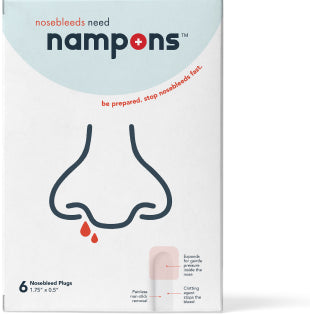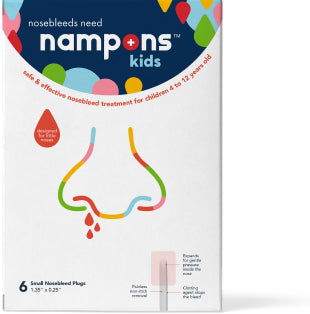The common cold is a type of upper respiratory infection (URI) caused by a number of different viruses, including the rhinovirus. It leads to runny noses, sneezing, nasal irritation, and a host of other symptoms.
But can the common cold cause nosebleeds and do these nosebleeds occur when your cold is breaking?
Let's find out!
Is It Normal For Your Nose To Bleed When You Have A Cold?
The common cold doesn't directly cause nosebleeds, but it could cause irritation and inflame your nasal passages enough to trigger a nosebleed.
When your nose runs, you wipe it. You might even blow your nose, leading to the comical red-nosed, droopy-eyed look that we all adopt when we have a cold.
All of that wiping irritates the inside of your nose as well as the outside, and as the blood vessels in your nose are very delicate, that irritation could be enough to cause a rupture.
If wiping doesn't trigger a nosebleed, then blowing your nose or sneezing every few minutes probably will.
Not everyone suffers from nosebleeds when they have a cold, of course. Some people are more susceptible than others. But if you generally suffer from regular nosebleeds, either as a result of nose picking, nose blowing, allergies, sinus issues, or fragile nasal membranes, there's a good chance you'll bleed more when you have a cold.
Nosebleeds are also more frequent when your nasal lining is dry and cracked. This can occur as a result of dry air, dehydration, and even cold medications, which can dry the nose and dilate the blood vessels.
Does a Nosebleed Mean my Cold is Breaking?
A nosebleed is not necessarily a sign that your cold has peaked and is finally turning a corner. But it can be.
After all, unless you are very susceptible to nosebleeds, you probably won't suffer a bleed the first time you sneeze or wipe your nose. It takes time for your nose to become irritated, and those irritations increase as your cold progresses.
In other words, you may be more prone to nosebleeds toward the end of your cold, but that's not necessarily the only time you'll get them.
What is the Typical Cycle of the Common Cold?
The exact life cycle of the common cold varies depending on the individual and the type of infection. However, it usually follows stages similar to the following:
The Incubation Period
The incubation period is the length of time between infection and first symptoms. Where the cold is concerned, it usually takes no more than 2 days, but it's possible for symptoms to appear in as little as 12 hours.
Stage 1
The early stages of a cold can include symptoms such as a scratchy, sore throat, as well as the feeling that there's something stuck at the back of your throat and/or nose.
You may also experience occasional sneezing and a feeling of fullness as the mucus increases.
This stage generally lasts for between 2 and 3 days.
Stage 2
This is when the symptoms peak, with mild throat irritation giving way to heavy nasal discharge and nasal congestion.
You may experience a fever at this point, although these are more common in young children.
The second stage will last for 2 or 3 days, taking you to between the 5th and 7th day of your cold.
You may suffer from nosebleeds, especially if you have been sneezing a lot and blowing your nose.
Stage 3
At the final stage, you begin to get back to normal. Your nose will likely be very dry and irritated, so nosebleeds can occur.
This is when you should get out the saline nasal spray to protect the nasal lining and the delicate blood vessels underneath.
How to Prevent Nosebleeds When You Have a Cold
It's important to keep your nose moist when you have a cold, and that doesn't mean you should just let the snot run!
If you're wiping your nose, use moistened and/or medicated tissues that are delicate on your skin. Refrain from blowing your nose too much and don't stick your finger in there if you can avoid it.
Toward the end of your cold, when your nose is dry, inflamed, and irritated, use nasal saline spray or a little dab of petroleum jelly to keep the area moist.
If your nose bleeds while you have a cold, keep calm, sit down, lean forward, and pinch the soft part of your nose. Hold this pinch for 10 minutes and then release.
The bleeding should have stopped, although you may still notice some blood in your mucus.
Don't pick or blow your nose after stopping a nosebleed, as you could dislodge the clot. You should also avoid showering, bathing, and performing any strenuous activity immediately afterward.
If you notice heavy bleeding, and it doesn't stop after 20 minutes, seek emergency medical attention. Most nosebleeds occur in the front of the nose, known as "anterior nosebleeds".
These are often harmless and short-lived. However, if you have a posterior nosebleed, which occurs in the back of the nose, the bleeding may be heavier and the cause may be more serious.
Caution is also advised in individuals taking blood-thinning medications or suffering from a blood clotting disorder.
What Does A Sudden Nosebleed Mean?
A sudden nosebleed could mean a number of things, most of which are harmless.
It indicates that the delicate blood vessels around the nasal septum have been damaged. This can happen as a result of damage from a fingernail, as well as a sneeze, blow, or direct nasal trauma. You may also suffer from a sudden nosebleed if you have spent a lot of time in a very dry environment, as the nasal membrane lining will dry and crack.
It should go without saying that a broken nose can also cause a sudden nosebleed.
Are Nosebleeds Common With COVID?
COVID symptoms developed over time as new variants spread, more reports were gathered, and scientists picked through the data.
Several times between 2020 and 2022, it was reported that frequent nosebleeds were a COVID symptom. In actual fact, it's likely that these nosebleeds were the result of other factors.
For instance, they were more commonly reported during allergy season and when people were using their air conditioning more.
COVID also placed a lot of stress on the sinuses, and some variants were more likely to cause running noses and sneezing than the typical "COVID cough".
And if you suspected that you had COVID, there's a good chance you gave yourself a COVID test and jammed a cotton swab up your nose.
Once you combine the invasive cotton swab with a dry environment and nasal irritation, you're asking for a nosebleed.
Summary: Nosebleeds and the Common Cold
Nose bleeding can occur at any point during a cold but may appear more frequently toward the end, by which point your nose is dry and your nasal lining is damaged.
You may also suffer from nosebleeds when you have the flu or COVID-19. Most nosebleeds are harmless and caused by picking, blowing, and dry air. But frequent or severe nosebleeds could indicate a serious underlying health condition and should be reported to your healthcare provider.



